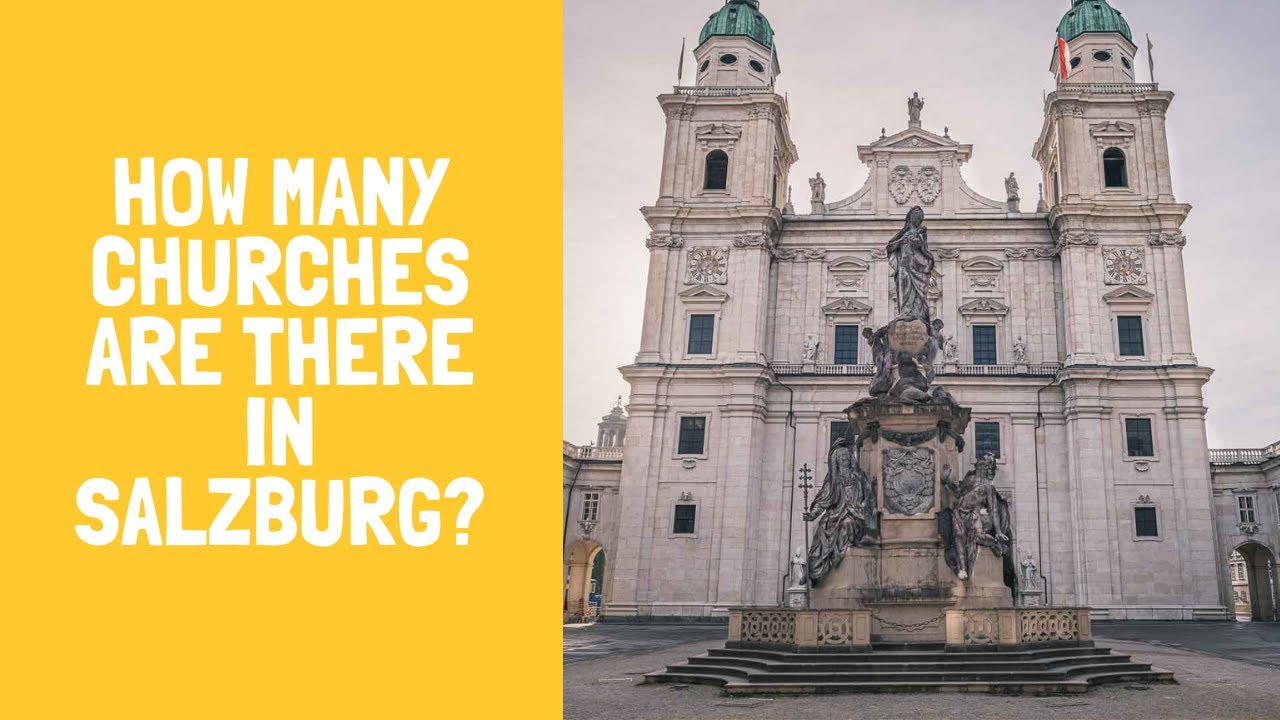22 Churches in Salzburg: A Guide to the City’s Sanctuaries
If you have been to Salzburg, you know that the old town is small. It’s just about 1.5 km². How many churches can there possibly be in the old town, you ask?
In the old town of Salzburg, there are 22 churches.
When walking the streets of Salzburg, you will find a church on every corner.
Listen to the Episode on the Free Walking Tour Podcast instead!
The Guide to Churches in Salzburg
This article is a guide to all of these churches with a suggested route and necessary information. The order doesn’t reflect the importance of each church.
You could follow along in this order and visit not only the churches but every part of the old town along the way. Be aware that there are two mountains to climb in case you visit all of the churches. An entrance fee is only required to access the fortress, which also features a church. Just skip it if you don’t want to spend money.
Here is the suggested route to visit every church and all of the old town:
Like with all of my self-guided tour guides on this website, the walk begins at the entrance of Mirabell gardens, but with this one, we don’t actually enter the garden.
1. Holy Trinity Church
The trinity church at Makartplatz square, right outside Mirabell garden, is one of four churches built by the most famous Austrian architect from history. Fischer von Erlach was the architect of Schönbrunn castle, the most visited sight in Austria, and shaped the artistic taste of the Habsburg dynasty in Vienna during baroque times.

Remember the facade of the trinity church when visiting the University church on the opposite side of the river. Here at the trinity church, we have an oval shape that is pulled inside. The University church faces and mirrors the University Church on the other side of the river with an outward pulled oval-shaped entrance.
You can visit the inside of the church, but there is a fence keeping you from going in all the way. If you would like to get all the way in, you could politely ask at the reception of the Priesterseminar (priests seminar) guesthouse. The guesthouse is the entrance on the left when facing the church. Getting all the way in is worth for the marvelous paintings on the ceiling.
2. Loretto Church
The Loretto Church belongs to a monastery that was founded during the 30-year war at the beginning of the 17th century. It provided refuge to Capuchin nuns from a war devastated village in Bavaria. The Loretto monastery is one of the seven active monasteries in Salzburg.
Their monastery rules and their regimen were among the strictest in the catholic church. The convent is still more conservative than other modern monasteries. Therefore, the church attracts more pious believers than other places.
Furthermore, the Loreto monastery has a small puppet made in the 17th century. It’s made of jewels and ebony that wealthy donors contributed to creating the doll. That puppet is the reason for pilgrimage. It’s customary to have one of the nuns put the doll on your head to bless you. Moreover, they set up the puppet in the church on holidays.
The blessing ritual is not free. Quite the opposite so you might want to skip that.
You find the entrance to the church embedded in the wall at the bus stop in Paris Lodron street. From outside, it’s not apparent that there are a church and a monastery.
3. Saint Andrews Church
At Mirabell square, Saint Andrews Church was initially built in the 19th century as a replacement for another church of Saint Andrew that burned down during the fire in 1818. The replacement church, however, was just as severely damaged during world war II. That’s the reason for the church’s modern appeal and the plain interior.
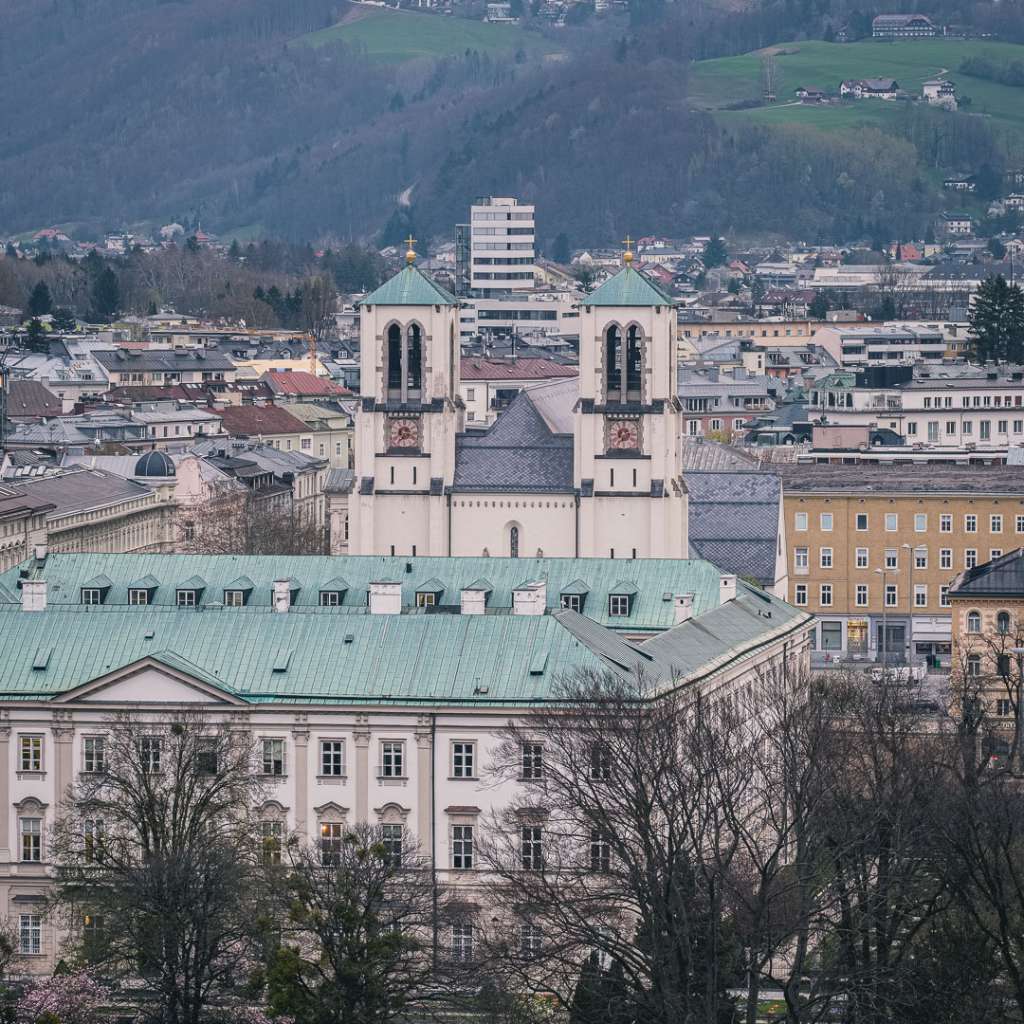
Saint Andrews is nowadays used by the Croatian community of Salzburg. Mass at Saint Andrew’s is held therefore held in the Croatian language. Every Thursday the most traditional farmers market of Salzburg, the Schranne, takes place.
4. Old Catholic Church
From outside, you barely notice the old catholic church. Only door in the Mirabell castle wall, opposite of Saint Andrews church, is visible. The old catholic church is a spin-off church of the Roman-Catholic church. Other than the name suggests, it’s from the 19th century. The word old refers to them trying to orientate their religion on the initial Christian values.
The church itself dates back to around 1600 when Mirabell castle was built. Wolf Dietrich, the archbishop who built Mirabell for his mistress, included a private church for her. That church was modified around 1700 together with the castle and the garden.
The entrance to the church is embedded in Mirabell castle and located next to the main entrance. Unfortunately, it’s almost always closed. The only times when it’s open is for mess every Sunday at 10 am and for the occasional paid concerts.
5. Protestant Christ Church
Because the catholic church ruled Salzburg for more than 1000 years, religious progress was slower than in other parts of Europe. Only in 1860, when the archbishops were not in power anymore, it became possible to build a protestant church.
The red brick building on the left side of the river is on many popular photographs and postcards of Salzburg. The so-called Christ church was built according to the Eisenacher Regulativ. The rules from 1861 on regulated how protestant churches were built.
6. Müllnerkirche Church
Depending on your interests, this might be one of the most exciting churches. Not because of the church itself but because the church belonged to the Augustine monastery and the Augustinian monks, same as in Munich, were beer brewers. Nowadays, there is no monastery anymore, but the beer brewery still exists.

The Müllnerbräu or Augustinerbräu building is connected to the church and nowadays the biggest beer hall in Austria. But beer is for another article. We are talking about churches here. The church with the staircase to reach the interior is as worth visiting as the beer brewery.
7. Saint John’s Church
This is one of two churches in Salzburg dedicated to Saint John the Baptist and one of the four churches built by Fischer von Erlach. Technically, Saint John’s church isn’t in the old town. The surrounding buildings are the state hospital of Salzburg.
The church was built in 1700, when the hospital was established.
The gate that’s still next to the church was one of the city gates, but the walls and the surrounding buildings were replaced by the hospital. Even if the church is part of the hospital, it’s open to the public.
8. Saint Marcus Church
Like Saint John’s Church, Saint Marcus is another one of the four churches built by Fischer von Erlach, the famous Austrian baroque architect. We have no proof that the church is another one of his works, but Fischer’s style is so distinct that there is no doubt about the authorship.
The previous church was destroyed in the rockfall of 1669 in which 200 people in Gstättengasse, the alley next to the church, died. That former church was actually consecrated to Saint Marcus. Today’s church is dedicated to Saint Ursula, but we use both of the names until this day.
The buildings attached to the church and extending it to the rear were first a hospital, then a seminar for priests and later a school. Now, among other things, the building houses the museum of natural science. The church nowadays serves the Ukrainian community of Salzburg.
9. Saint Blaise Church
This is one of the few gothic churches in Salzburg. It’s also called Bürgerspitalkirche (Civil Hospital Church) because it belonged to the affiliated Bürgerspital hospital. You can have a look at the hospital buildings as well. They are next to the church where the entrance to the toy museum is located.
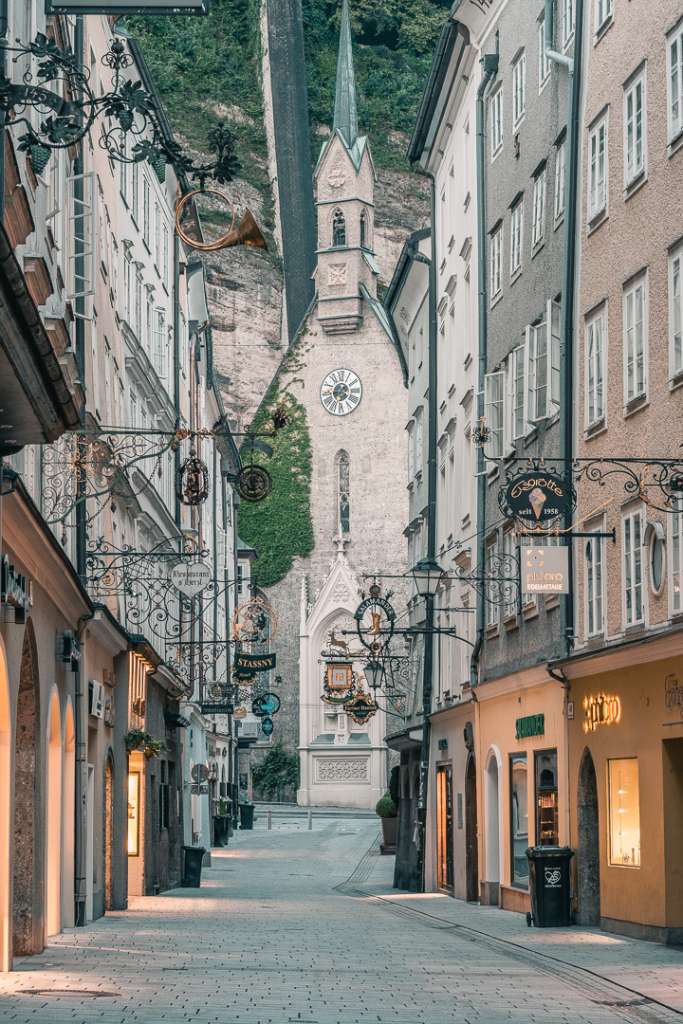
That hospital was more like a retirement home than a hospital, and in the past the church had a cemetery for deceased inmates of the hospital. Some of the gravestones can be found underneath the arches in the yard of the hospital as well as at the entrance of the gothic hall next to the church.
The church itself is one of the darkest churches I have ever seen. When there is no mass, there is a fence, and you can only enter the rear part of the church. But it’s anyway more attractive from the outside than from the inside.
10. Sacellum
The university in history was run by the monasteries. From when the university was founded in 1620 they used the Sacellum for their mass. From the outside, you won’t even recognize the Sacellum as a church. It’s just a door in the wall of the old University building and the interior is rather a chapel than a church. That’s why the University Church had to be built 80 years later.

But the interior of the church was adapted to various styles of art over time. Therefore, the altar and the paintings on the ceiling are from baroque times. Unfortunately, the Sacellum is always closed except for mass on Sundays at 11.30 am. That mass, however, is a chance not only to see the church, but it’s one of the few masses in Salzburg that’s held in the English language.
11. University Church
The University Church is one of the most important and one of my favorite churches in Salzburg. It was not only the last of the four churches by Fischer von Erlach but the last historic building in the old town of Salzburg. Because the old town is surrounded by mountains and divided by the river, space was limited. There was no more space around 1700 before in the 1860s the walls were taken down and the river regulated.

This church is unlike any church you have seen before. There are no paintings on the walls and no benches. The church benches were most likely removed when the french occupied Salzburg and closed the university. Paintings, however, were never part of Fischer von Erlach’s concept. He also faced criticism for the fact that the church looks less like a church and more like a palace.
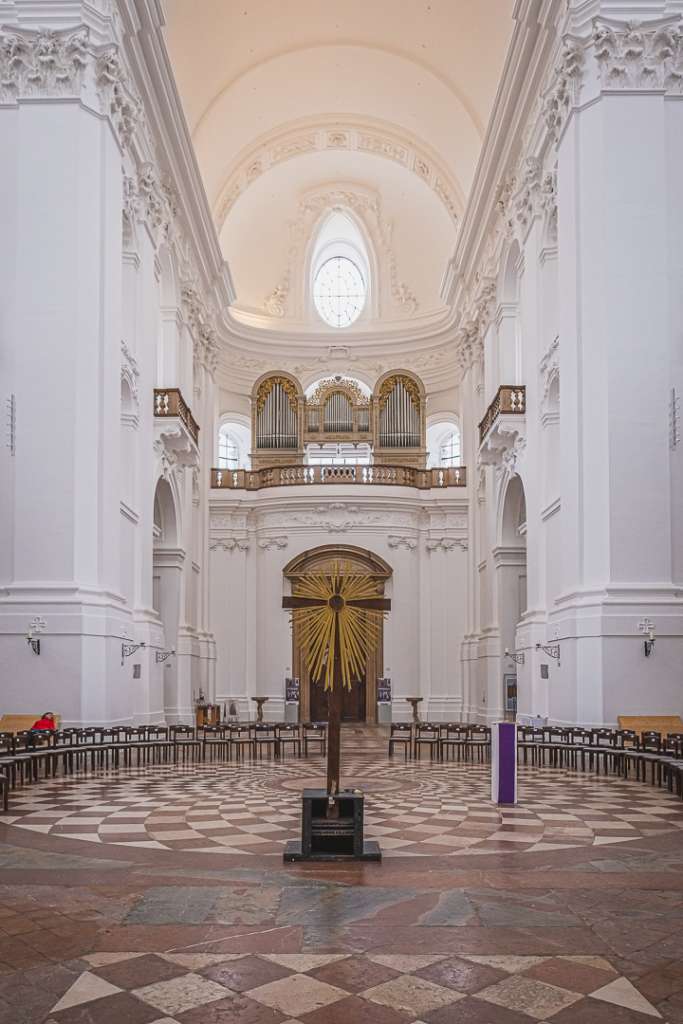
Anyway, I consider this church one of the 15 must-see sights in Salzburg, even if it is not overly popular with tourists. When you visit, you lie down on one of the sloping benches to become aware of the large space and enjoy the peace before you enter the turmoil again.
12. Franciscan Church
The Franciscan Church is not only one of the most important churches in Salzburg but another one of the must-see sights in Salzburg. You have to see the interior of the Franciscan church. From the outside, you barely notice it when walking the narrow alleyways. The gothic tower, however, is visible from every viewpoint in Salzburg.

But the interior of the Franciscan church is what’s actually of interest. Upon entering, you face a long, dark, romanesque nave from the 13th century. That’s one of the oldest buildings in Salzburg. It’s dark because during baroque times oratories were built and cover the windows on the side naves of the church.
Reconstruction and adaptation to various style of art is the theme of the Franciscan church. The chapels surrounding the altar were built around 1600 and furnished during the 17th century from left to right by different archbishops and wealthy donors. Therefore, you notice the evolution of style from the first to the last chapel. Notice also the windows on the left when facing the altar. They belong to the archbishop’s residence and were a convenient way for the ruler to attend mass without leaving the house.
13. Saint Peter’s Church
The monastery of Saint Peter’s is where Salzburg was founded. Salzburg was founded by a Bavarian bishop named Rupert. Rupert, who is considered a Saint nowadays and is the patron Saint of Salzburg, was sent from Bavaria in the year 696 to convert the people in the East to the Catholic religion.
However, when he was faced with resistance, he decided to settle in the area of Salzburg.
Salzburg was an excellent location to settle because of the mountains, the river, and of course, because of the salt. A lot has happened since the city, and the monastery was founded, and none of the church of Saint Peter’s dates back to that time.

Saint Peter is, together with the Franciscan church, the best place to understand art history. An art historian once told me many churches, but Saint Peter in particular, are like onions. Layers were added every time the fashion changed.
The substance of the oldest parts of Saint Peter’s church is from the 9th century. But these are not visible anymore. Therefore the entrance and the tower are the oldest visible parts of the church. But while the bottom of the tower is Romanesque, the typical onion-shaped top of the tower is from the middle of the 18th century; the heavy interior is partly baroque and partly rococo.

While you can only visit the church, the cemetery, and the two yards at Saint Peter’s, the monastery harbors many more treasures. It was not only the religious but the cultural center of Salzburg, the oldest city in Austria. Therefore Saint Peter has the oldest library in Austria with more than 100.000 books and the oldest book being from 784.
The cemetery of Saint Peter’s is a must visit. There is Mozart’s sister’s grave and on the other side of the cemetery you could try bread from the oldest bakery in Salzburg.
14. Salzburg Cathedral
Cathedrals are the churches of bishops. In the case of Salzburg, the cathedral is even the church of an archbishop. In Salzburg, these archbishops were called prince-archbishop in the past because they had all the power. Therefore, the cathedral was not only the most important church in a city that is full of churches but also the center of power.
The Salzburg cathedral was the first baroque church in Austria. That’s because when it was built and consecrated, the rest of Europe was fighting the 30-year war while independent Salzburg remained neutral. But the year 1628, the year when today’s cathedral was consecrated was not the first time Salzburg got a cathedral.

The first cathedral was built in 774. That cathedral burned down in the 12th century and was rebuilt, but in 1598 the church burnt one more time. At that time, Wolf Dietrich, the most notorious archbishop from history, ruled over Salzburg. It was him who transformed Salzburg into a baroque city, and the fire gave him a reason to plan a baroque cathedral.
For that purpose, he brought Italian architects. They were the experts when it came to baroque art. However, Wolf Dietrich took 14 years to make a plan, and the ambitious archbishop ended up imprisoned in his own fortress before the cathedral construction began. It took 30 years until the cathedral you see today was finished.
The finished cathedral was regarded as such a masterpiece that, unlike so many other churches, it remained mostly unmodified. During the second world war, however, a bomb hit the dome of the cathedral. Because a lot of the city was damaged, it took until 1959 before the damage was repaired.
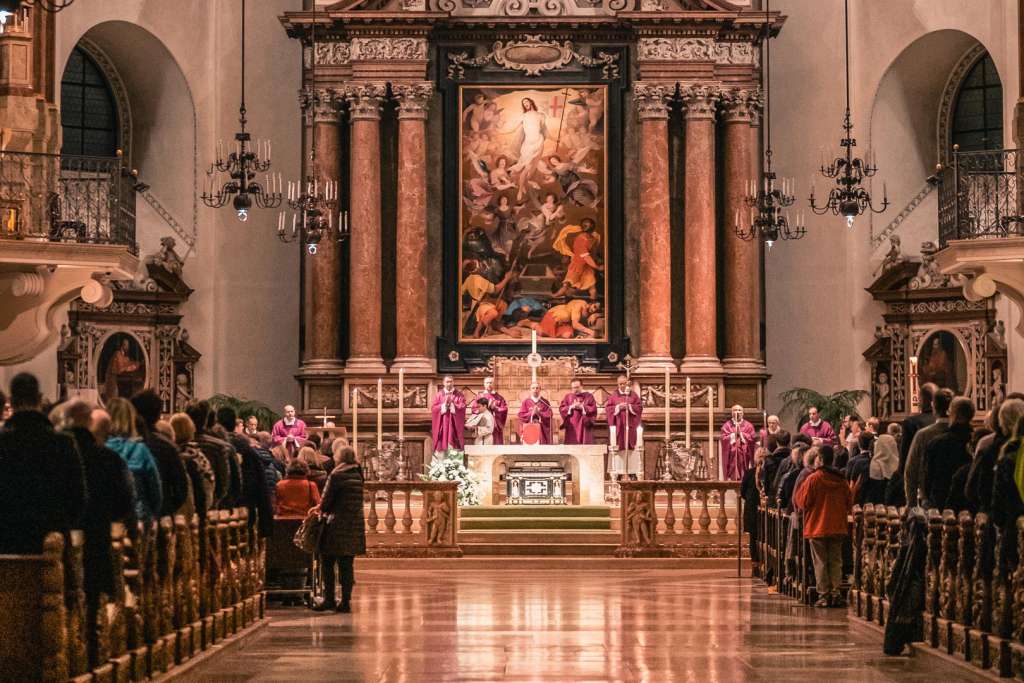
When you stand in front of the cathedral, you will see three numbers above the entrances. Now you know what they mean. In 774, the first cathedral was built, in 1628, today’s cathedral was consecrated, and in 1959 it was renovated after the second world war.
If you would like to know more about the Salzburg Cathedral, here is an article on some of the cathedral’s details and why it’s a must-see in Salzburg.
15. Saint Michael’s Church
If you visited Saint Peter’s before and noticed the beautiful Rococo stucco on the ceiling and the wrought iron fence, Saint Michael’s church at residence square might seem familiar. That’s because it’s affiliated to Saint Peter and was modified at the same time and by the same artists as Saint Peter’s church.
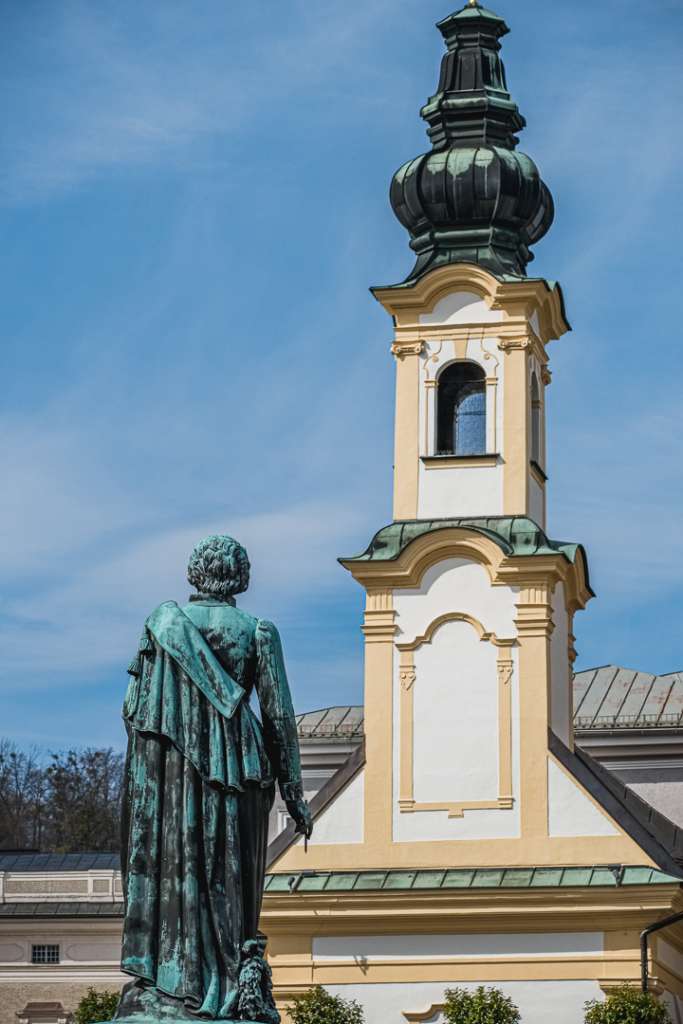
Saint Michael’s is a modest church. It’s tiny, but it’s the oldest church in Salzburg. Same as the Franciscan church, Saint Michael’s church dates back to the 8th century. Back then, it was the parish church for the citizens of Salzburg as well as the church for the emperor and his people when he resided in Salzburg.
16. Saint George’s Church
The church of Saint George is the only church that requires an entrance fee. That’s not because they charge you for the church but because it’s located inside the Salzburg fortress. If you are only after churches and were not planning to visit the fortress, just skip it. It’s a small church. Interesting, but you wouldn’t miss anything if you skip it.
You see the tower of the church from everywhere in the city. It’s embedded in the walls of the fortress. If you decide to enter the fortress, you either take the funicular or walk. If you walk, you save a few euros, but the funicular is convenient and fun.
The church is from around 1500 and in the late gothic style. At that time, Leonhard von Keutschach, who was regarded as the last medieval ruler of Salzburg, upgraded the fortress to provide him with a refuge from his citizens. They were angrier and angrier because of his authoritarian leadership. Keutschach changed so many parts of the fortress that his coat of arms can still be found 58 times on buildings inside the fort.

On the outside of the church, you find a memorial for him. On the bottom right of that memorial, you find his coat of arms. A beetroot. Every time you see the beetroot inside the fortress (58 times), you know the building is from the time of Keutschach. Inside the church, you will find reliefs of the twelve apostles and a baroque altar. Nothing special. The entrance is closed with a church grid.
A date worth mentioning is the 23rd of April, the day of Saint George. Saint George is the patron saint of the riders and the horses. The custom for horse owners in Austria is to ride the horse to the church and around the church on Georgstag. Since the church of Saint George in Salzburg is located on the fortress, the riders come from the surrounding areas to ride their horses to the fortress.
The first time I became aware of that tradition was when I happened to visit the fortress with a Couchsurfer on the 23rd of April. We were wondering why the path to the fortress was lined with horse droppings. Unfortunately, the riders can not ride around Saint Georges church in Salzburg because one side of the church is the fortress wall.
17. Nonnberg Abbey Church
Nonnberg Abbey is unique and not only because it’s featured in the Sound of Music. The convent is the oldest nunnery in the world. It was founded in 712 by Saint Rupert, the founder of Saint Peter’s monastery and the city. Initially, the convent was a refuge for noblewomen. Saint Rupert brought his relative Erentrudis and her fellowship from Bavaria to become the first Abyss and lead the order.
Like Saint Rupert, Erentrudis, later on, became a Saint. She is portrayed as a nun with the church as a symbol. In many churches in Salzburg, you will find her statue.
You also find her statue when you walk over from the fortress to the monastery or climb the Nonnbergstiege stairs before you enter the monastery ground. Nonnberg abbey over time evolved from a convent for noblewomen to a Benedictine monastery with strict rules. The church in its core is gothic, but there were romanesque paintings from an earlier building, and during baroque, the church has been modified with chapels.
However, in general it’s gothic apparel is preserved.
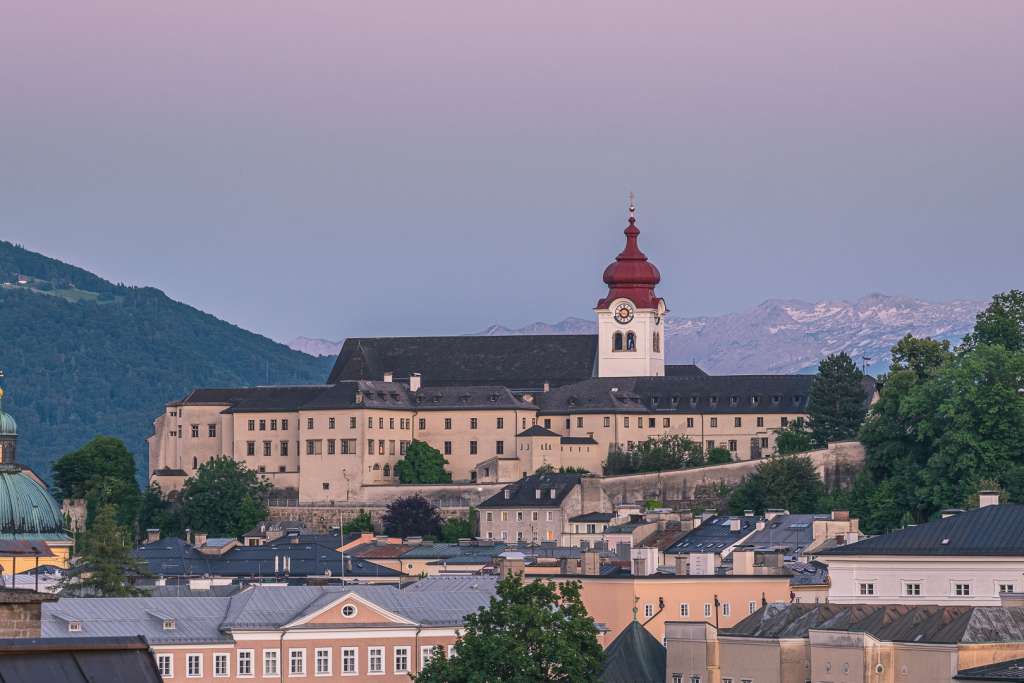
You can’t visit the monastery itself, but you should visit the church. When entering the church, you find romanesque paintings on the left. Well, you only find them if you put a fifty-cent coin into the payment box. That’s how you turn on the light that reveals the paintings. I would highly recommend doing so. When you visit, be very respectful.
Nonnberg Abbey is an active convent. Most of the nuns live in solitude, and they are not happy with tourists carelessly invading their space.
If you are looking for a unique experience at Nonnberg and you can get up early, attend their morning prayer at 6.45 am. When you do, you won’t see the nuns. They are behind a fence, hidden from the public, but you will hear them. At the dimly lit church that’s hundreds of years old, their singing and their prayer are a truly mystical experience.
And as I mentioned at the beginning, Maria from the Sound of Music was a teacher and a candidate to become a nun at the monastery in real life and a nun at the monastery in the movie. You see Nonnberg abbey at the beginning of the film and again when she returns to it. Still, while the captain and Maria married at Nonnberg in real life. However, the wedding scene took place in Mondsee in the lake district.
18. Saint Erhard
Saint Erhard is just below the church of Nonnberg abbey. An earlier chapel belonged to a hospital that was part of the monastery. That’s what the buildings to the left and the right of the church were. The chapel was taken down in the second half of the 17th century. The new church was then commissioned from an Italian architect. Saint Erhard’s church was one of the last two churches built by Italians in Salzburg.

The entrance to the church is elevated because, in history, floods have devastated the area. In the middle of the base, before climbing the stairs, there is a fountain. The water of that fountain was said to have healing powers that were convenient for the hospital. Like in a few other churches, most of the time, there is a grid preventing you from going all the way into the church.
19. Kajetan Church
Built by Giovanni Gaspare Zucalli, the same Italian architect as the previous church, Saint Cajetan’s church is one of the last two churches built by Italians. Throughout the 17th century, baroque buildings in Salzburg were built by Italians. At the end of the 17th century, however, there was one archbishop who didn’t want Italian architects anymore.
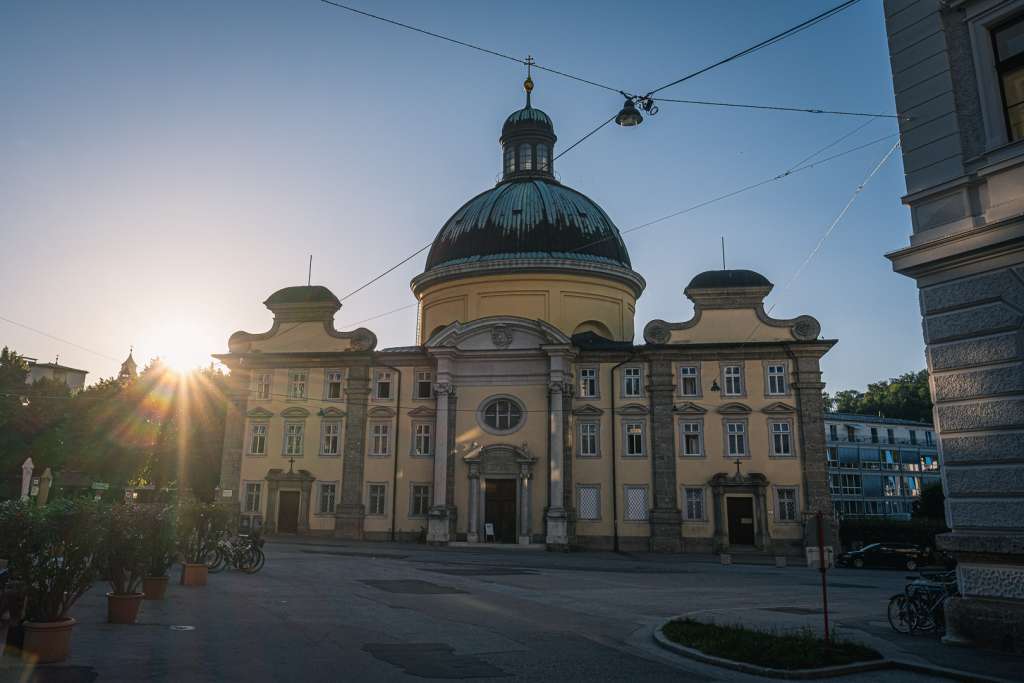
That archbishop stopped paying the architect of the Kajetan church. The sign above the door still points out that only with the help of unknown donors, it was possible to finish the construction of the Kajetan church. The surrounding building was initially supposed to serve as a seminar for priests. Instead, the archbishop assigned the seminar to the trinity church and there is a hospital at Saint Cajetan’s.
If you remember, the trinity church was the first church on this list. You maybe remember that it was built by the Austrian star architect of the baroque era, Fischer von Erlach. Well, the archbishop who didn’t want Italians anymore brought Erlach from Vienna and therefore preferred to assign the seminar to one of his churches.
An interesting context here is the ceiling painting. Although the Kajetanerkirche was started earlier, it finished much later than the Trinity Church, due to the lack of support by the archbishop. Therefore, the painter of the Kajetanerkirche could take the famous ceiling fresco of the Trinity Church as his inspiration.
Another interesting detail of Saint Cajetan’s church is the holy stairs. The holy stairs are a replica of the holy stairs in Rome, which are supposed to be the stairs that Jesus walked to his trial at the palace of Pontius Pilatus. There are 28 steps that you would only be allowed to climb on your knees. Unfortunately, you don’t often get the chance to do so. The stairs are only open for an hour on Saturday.
20. Saint John’s Church
The second church dedicated to Saint John in Salzburg’s old town is halfway up the stairs to the Capuchin mountain. It’s an inconspicuous church. When you climb these stairs to the mountain, you don’t recognize the church from the narrow staircase. You find the entrance after the first corner going straight instead of into the tunnel to the right.
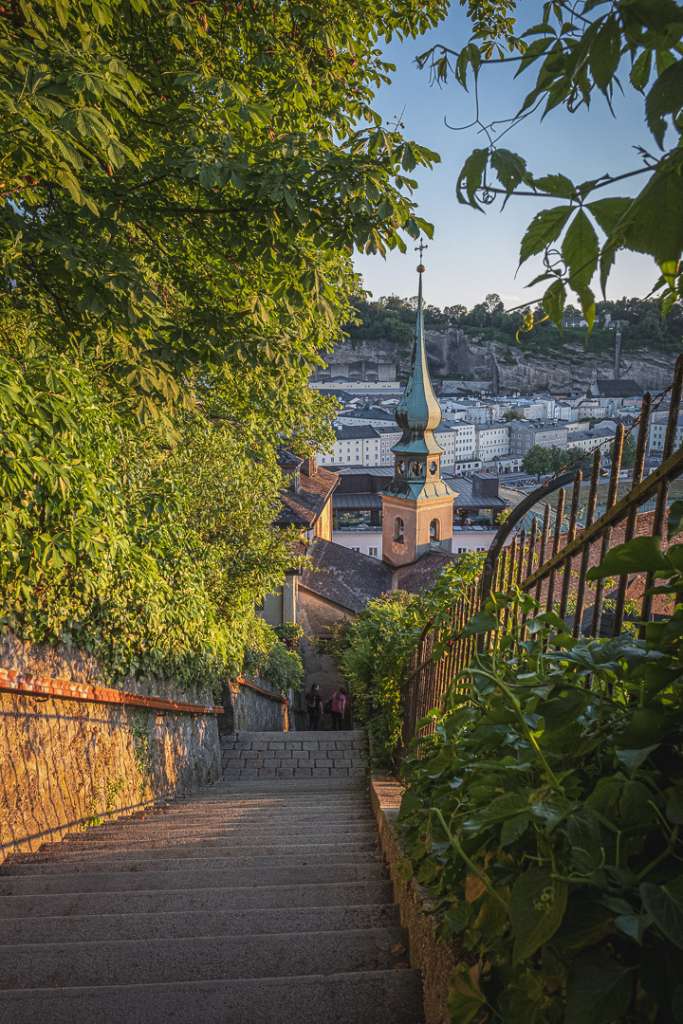
The church is in its core romanesque, but like so many other churches, it was modified during baroque times. That’s when the altar and the onion-shaped tower were added. Saint John’s church at the Imbergstiege staircase is open during the day. Still, it’s interior is protected with a grid.
The stairs wouldn’t be worth it just to see the church, but a hike on the Capuchin mountain is very rewarding.
21. Capuchin Church
Like the Franciscans, the Capuchin monks came to Salzburg at the end of the 16th century because of protestant religion gaining influence. Both of these orders are mendicant (beggar) monks. While the Benedictines, according to their rules, have to work and pray the mendicant friars were not allowed to have possessions.
Because they depended on donations, they were closer to the people and had more influence. That’s why the archbishops wanted them for the counter-reformation. The Capuchin monastery also became a place for pilgrimage. Along the road to the monastery and the church, there are the 12 stations of the cross.
The road is the alternative to the aforementioned Imbergstiege stairs. I would recommend to take the stairs on the way up and walk the street back down. After you reach the monastery, hiking to the top of the Capuchin mountain would be highly recommended. It would take you about an hour to the top and back.
The monastery, like most monasteries, can’t be visited but you can visit the church. Like the order of the Franciscan monks, the church is simple.
22. Saint Sebastian’s Church
When you take the street down from the Capuchin mountain, you end up in Linzergasse. There, at the end of the street is a church and behind that church there is one of my favorite places in Salzburg.
Initially, there was the cemetery for the plague when this place was still outside of the city walls. Saint Sebastian is the saint for the plague. You find a relief of him on the outside wall of the church. The young guy with the arrows in his body. Saint Sebastian was an early martyr in the Roman empire.
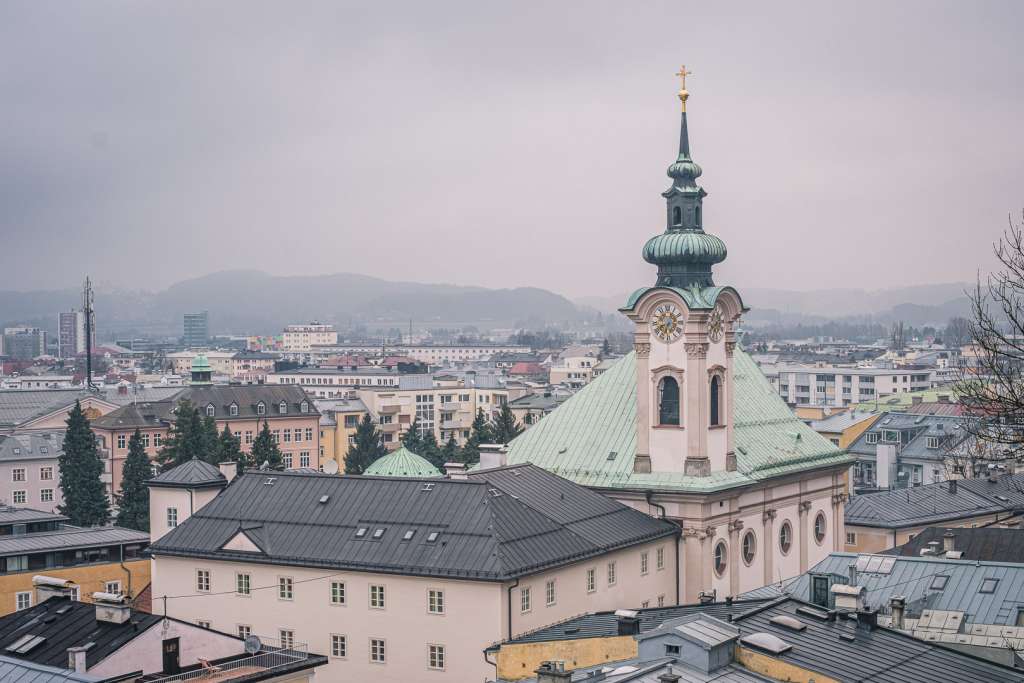
He was supposed to be killed with arrows, but these arrows didn’t kill him. Therefore he was clubbed to death. The connection with the plague was only made in the middle ages and is arbitrary. It was made because in greek mythology arrows were sometimes associated with sickness. That association made him popular when the plague raged. Therefore, in many places in Salzburg, you will see saints statues with arrows in their bodies.
Saint Sebastian’s church was severely damaged during the fire on the right side of the river in 1818. The interior was largely destroyed and not that interesting anymore. The fascinating part and one of my favorite places in Salzburg, is hidden behind the church.
When the area where Saint Sebastian’s is today became part of the city, they stopped using the cemetery for the victims of the plague. Instead, it became a small cemetery for the ordinary people. But when Wolf Dietrich, the ambitious archbishop who turned Salzburg into a baroque city, didn’t want the cathedral’s cemetery in front of his residence, he had to provide a new graveyard.
That’s when Saint Sebastian’s cemetery became the cemetery it is today. You do not only find Wolf Dietrich’s Mausoleum in the middle of the cemetery but there is also the Mozart family grave and the graves of a few more local celebrities. What I love about the cemetery, however, is the peaceful atmosphere. Take a walk around in the arcades.
To find the entrance to Saint Sebastian’s Cemetery, you look on the right when facing the church. In winter, when that entrance is closed, you have to walk into the yard on the left and around the building to find the side entrance.
Conclusion
These are the churches in the old town of Salzburg. The historical old town is only 1,5 km² out of 65km² that is the city of Salzburg. You can visit all of these churches in three to four hours. I would recommend them as a way of alternative sightseeing. Walking from one church to the other, you will discover every district in the old town. With the background information in this article, you will also learn about Salzburg’s history.



